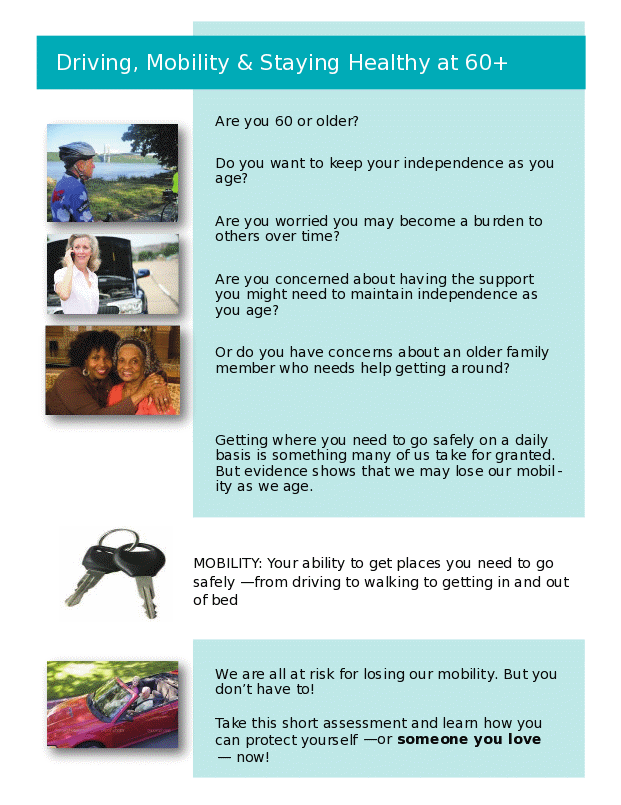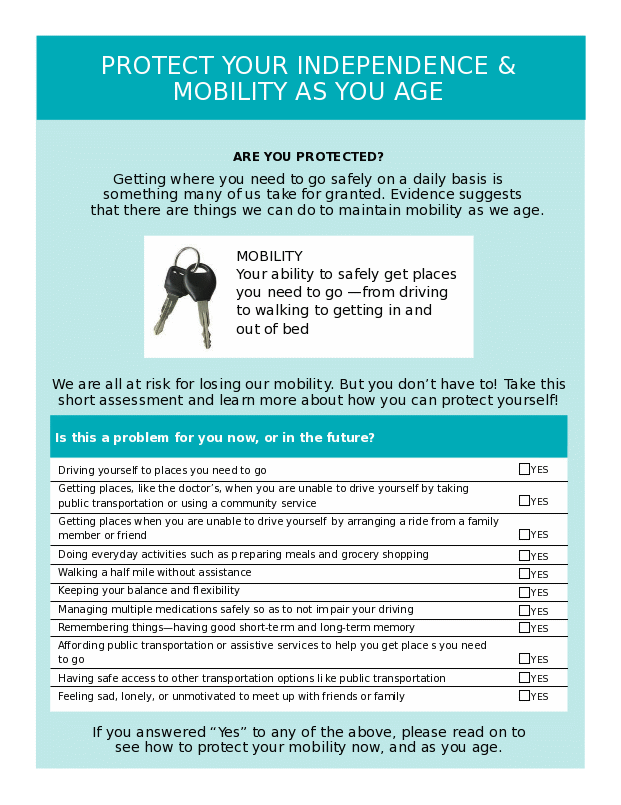Intercept Interview Guide
Older Adult Safe Mobility Assessment Tool
Att I- Intercept Interview Guide
Intercept Interview Guide
OMB: 0920-1005
Form Approved
OMB No. 0920-XXXX
Exp. Date:
Public
Reporting burden of this collection
of information is estimated at 30 minutes per response, including
the time for reviewing instructions, searching existing data
sources, gathering and maintaining the data needed, and completing
and reviewing the collection of information. An agency may not
conduct or sponsor, and a person is not required to respond to a
collection of information unless it displays a currently valid OMB
control number. Send comments regarding this burden estimate or any
other aspect of this collection of information, including
suggestions for reducing this burden to CDC/ATSDR Reports Clearance
Officer, 1600 Clifton Road NW, MS D-74, Atlanta, GA 30333; Attn:
PRA (0920-XXXX).
Older Adult Safe Mobility Assessment Tool Development:
Intercept Interview Guide
Introduction
Hi, my name is ____________, and I’m conducting research on behalf of the Centers for Disease Control and Prevention to help them create a resource for people who are 60 years old or older that will help them protect their ability to get to places they need to go as they age. We’re offering a gift card for people who talk with us today—it takes about 30 minutes, and we’ll be asking you to look at these documents and giving us your opinions. You qualify if you’re between 60 and 75 years old. Are you between the ages of 60 and 75? Would you like to help us out today? Great!
Warm up (5 MINUTES)
I have a couple of questions just to get us started.
1. In terms of getting around town, to the doctor’s or to shopping, how do you get to where you need to go now?
a. (Probe: Car, public transportation, transportation service, family/friends)
2. What are some of the challenges you experience in getting to where you need to go now?
a. Please explain how big of a challenge these things are for you?
Fast-forward 10 or 15 years, and think about how able you might be to get where you want to go on your own, like you do today.
3. What issues might come up as you’re in your 80s or 90s in terms of you being able to get where you need to go safely?
4. What would you think would make getting to where you need to go easier for you?
Feedback on the tool—individual (20 MINUTES)-
We have developed a couple of versions of a resource designed to help folks think about protecting their abilities as they age so they can continue to get around on their own. There are two different versions of the resource, and we’d like your opinions on both. What we’ll do is give you this one on a clipboard here and have you read it over and complete it as you normally would. As you read it over, please circle things you react to positively and cross out things that give you a negative reaction, like, you wouldn’t read it, you don’t like the picture, it doesn’t make sense to you, that kind of thing. When you’re done reviewing the entire document, I’ll ask you a few questions about it and fill out this worksheet as we talk.
 WORKSHEET
FOR THIS VERSION:
WORKSHEET
FOR THIS VERSION:
5. What’s your first impression of the resource, in a few words?
6.
W![]()
![]() hat’s
your overall reaction to this resource? (circle
one)
hat’s
your overall reaction to this resource? (circle
one)
![]()
Thumbs up Neutral Thumbs down
7. Consider the entire document—What made it easy to understand?
8. Consider the entire document—What made it vague or confusing?
9. Consider the entire document—What issues did it describe that you care about?
10. What made the self-assessment section easy to complete?
11. What made the self-assessment section hard to complete?
 WORKSHEET
FOR THIS VERSION:
WORKSHEET
FOR THIS VERSION:
12. What’s your first impression of the resource, in a few words?
1![]()
![]() 3.
What’s your overall reaction to this resource? (circle
one)
3.
What’s your overall reaction to this resource? (circle
one)
![]()
Thumbs up Neutral Thumbs down
14. Consider the entire document—What made it easy to understand?
15. Consider the entire document—What made it vague or confusing?
16. Consider the entire document—What issues did it describe that you care about?
17. What made the self-assessment section easy to complete?
18. What made the self-assessment section hard to complete?
Now we’re going to dive a little bit deeper in comparing these two versions.
19. Looking at the first section, before the actual self-assessment that you fill out—which one of these is better at getting you interested in reading more?
a. Because…
b. Were you turned off by anything in this first section? Tell me about that.
c. What could make this first part more appealing to you?
Now let’s compare the two self-assessment sections.
20. Which version do you prefer? PROBE
a. Combining now/later versus separating
b. Overall length; number of checkboxes
c. Someone you love
d. Encouragement to move on to tips section
21. After the self-assessment, there were some tips and an action plan. What did you think of those sections? PROBE: hard/easy to understand; useful; which you liked better
Closing (5 MINUTES)
22. What is the one piece of advice you would want to give to the people creating this resource to make it more effective?
23. After hearing all you’ve heard today/tonight, how interested are you in completing the assessment to learn more about ways of protecting your mobility?
a. Because…?
b. What one thing would most motivate you to pick up this resource?
c. Where would you want or expect to pick something like this up?
THANK AND HAND INCENTIVE
| File Type | application/vnd.openxmlformats-officedocument.wordprocessingml.document |
| Author | Roxana Said |
| File Modified | 0000-00-00 |
| File Created | 2021-01-24 |
© 2026 OMB.report | Privacy Policy